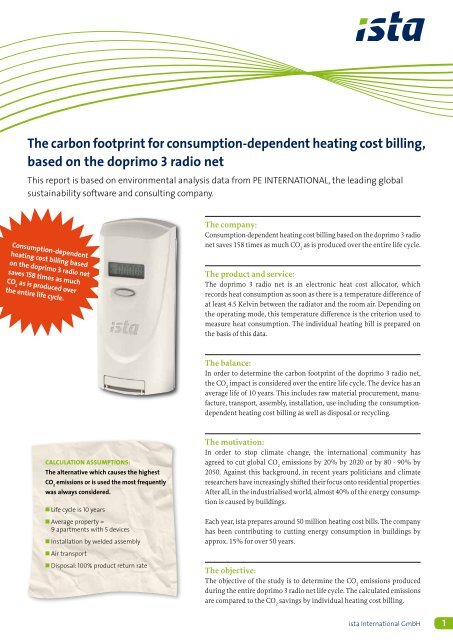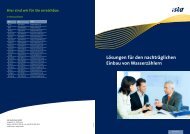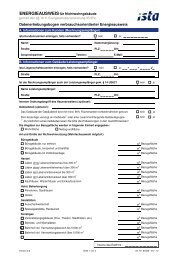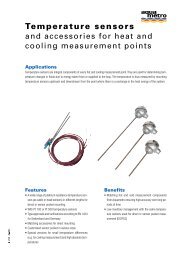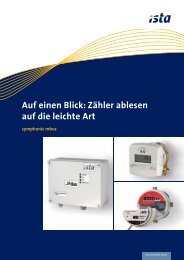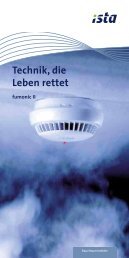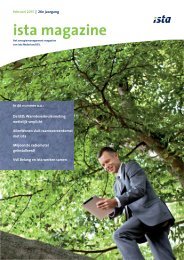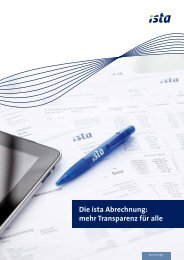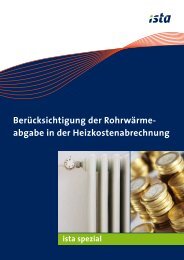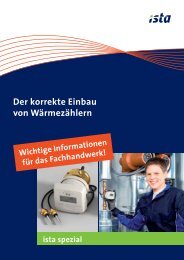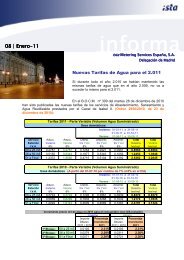Nachhaltigkeitsbericht 2009 - ista.com
Nachhaltigkeitsbericht 2009 - ista.com
Nachhaltigkeitsbericht 2009 - ista.com
Create successful ePaper yourself
Turn your PDF publications into a flip-book with our unique Google optimized e-Paper software.
The carbon footprint for consumption-dependent heating cost billing,<br />
based on the doprimo 3 radio net<br />
This report is based on environmental analysis data from PE INTERNATIONAL, the leading global<br />
sustainability software and consulting <strong>com</strong>pany.<br />
Consumption-dependent<br />
heating cost billing based<br />
on the doprimo 3 radio net<br />
saves 158 times as much<br />
CO 2 as is produced over<br />
the entire life cycle.<br />
CalCulation assumptions:<br />
The alternative which causes the highest<br />
CO emissions or is used the most frequently<br />
2<br />
was always considered.<br />
■ Life cycle is 10 years<br />
■ Average property =<br />
9 apartments with 5 devices<br />
■ Installation by welded assembly<br />
■ Air transport<br />
■ Disposal: 100% product return rate<br />
The <strong>com</strong>pany:<br />
Consumption-dependent heating cost billing based on the doprimo 3 radio<br />
net saves 158 times as much CO 2 as is produced over the entire life cycle.<br />
The product and service:<br />
The doprimo 3 radio net is an electronic heat cost allocator, which<br />
records heat consumption as soon as there is a temperature difference of<br />
at least 4.5 Kelvin between the radiator and the room air. Depending on<br />
the operating mode, this temperature difference is the criterion used to<br />
measure heat consumption. The individual heating bill is prepared on<br />
the basis of this data.<br />
The balance:<br />
In order to determine the carbon footprint of the doprimo 3 radio net,<br />
the CO 2 impact is considered over the entire life cycle. The device has an<br />
average life of 10 years. This includes raw material procurement, manufacture,<br />
transport, assembly, installation, use including the consumptiondependent<br />
heating cost billing as well as disposal or recycling.<br />
The motivation:<br />
In order to stop climate change, the international <strong>com</strong>munity has<br />
agreed to cut global CO 2 emissions by 20% by 2020 or by 80 - 90% by<br />
2050. Against this background, in recent years politicians and climate<br />
researchers have increasingly shifted their focus onto residential properties.<br />
After all, in the industrialised world, almost 40% of the energy consumption<br />
is caused by buildings.<br />
Each year, <strong>ista</strong> prepares around 50 million heating cost bills. The <strong>com</strong>pany<br />
has been contributing to cutting energy consumption in buildings by<br />
approx. 15% for over 50 years.<br />
The objective:<br />
The objective of the study is to determine the CO 2 emissions produced<br />
during the entire doprimo 3 radio net life cycle. The calculated emissions<br />
are <strong>com</strong>pared to the CO 2 savings by individual heating cost billing.<br />
<strong>ista</strong> International GmbH<br />
1
4.04<br />
0.24<br />
-0.58<br />
dOprimO 3 radiO neT CO 2 emissiOns in kg<br />
■ Production ■ Installation ■ Use<br />
■ Dismounting ■ Disposal<br />
summary:<br />
In Germany alone, <strong>ista</strong> saves a good<br />
1.5 million tonnes of CO 2 emissions a<br />
year through the individual billing of<br />
heating costs. This is based on more than<br />
18 million heat cost allocators, which<br />
<strong>ista</strong> has installed in more than 400,000<br />
properties in Germany. Therefore, through<br />
consumption-dependent heating cost<br />
billing, each individual device produces<br />
an average CO 2 saving of 84 kg per year.<br />
This is offset by the CO 2 emissions<br />
caused by the doprimo 3 radio net<br />
during its entire life cycle.<br />
Consumption-dependent heating cost<br />
billing based on the data of the doprimo<br />
3 radio net, over the entire life cycle,<br />
therefore saves 158 times as much CO 2<br />
as is produced.<br />
The 0.53 kg of CO emissions<br />
2<br />
caused by the doprimo 3<br />
radio net per year correspond to<br />
the production cost of approx.<br />
100 sheets of virgin fibre paper.<br />
1.80<br />
0.01<br />
* The disposal phase takes into account specific recycling processes, assuming a 100% product<br />
return rate and maximum reuse of the recyclable <strong>com</strong>ponents.<br />
5 life cycle<br />
phases<br />
CO 2<br />
emissions<br />
Causes of CO emissions /<br />
2<br />
credit<br />
produCtion 4.04 kg raw material procurement, manufacture,<br />
transport, preparation<br />
More than half the CO emissions are<br />
2<br />
produced during manufacture of the<br />
printed circuit board and the battery.<br />
installation 0.24 kg Transport, assembly, storage<br />
90% of the CO emissions are produced<br />
2<br />
by the car journey to the property.<br />
The remaining 10% are caused, among<br />
other things, by the welded assembly<br />
and transport.<br />
use / reading 1.56 kg diesel consumption, electricity consumption<br />
The CO emissions are produced by transport<br />
2<br />
d<strong>ista</strong>nces and car journeys to the property<br />
in which the heat cost allocator is read<br />
once a year as well as by the electricity<br />
consumption of the reading device.<br />
use /<br />
0.13 kg energy consumption of the service centre<br />
serviCeCentre<br />
The CO emissions are incurred due to<br />
2<br />
use / billing 0.11 kg<br />
the electricity, water and heating energy<br />
consumption of the ServiceCentre, in<br />
which the <strong>ista</strong> employees prepare the bills.<br />
Transport, dispatch, paper<br />
The emissions are incurred because of<br />
the paper and printing of the bills,<br />
as well as by the fuel consumption<br />
along the transport routes.<br />
dismounting 0.01 kg Transport, storage<br />
The emissions are produced by travel to<br />
the property or to the logistics centre.<br />
disposal*<br />
0.16 kg Logistics, transport, disposal, recycling<br />
(Co emissions)<br />
2 The CO emissions are incurred because<br />
2<br />
disposal*<br />
(Co Credit)<br />
2<br />
of the transport routes and the disposal<br />
of individual <strong>com</strong>ponents.<br />
- 0.73 kg The credit results from recycling<br />
CO emissions are credited here by<br />
2<br />
reusing individual <strong>com</strong>ponents, for<br />
example the aluminium, or by further<br />
processing the precious metals.<br />
The 84 kg of CO emissions<br />
2<br />
saved each year by<br />
consumption-dependent billing<br />
based on the doprimo 3 radio<br />
net correspond to the production<br />
cost of approx. 15,800 sheets<br />
of virgin fibre paper.<br />
<strong>ista</strong> International GmbH<br />
2


